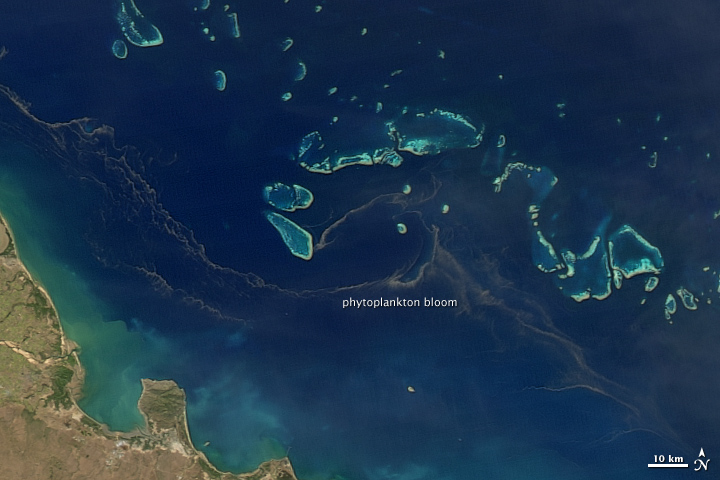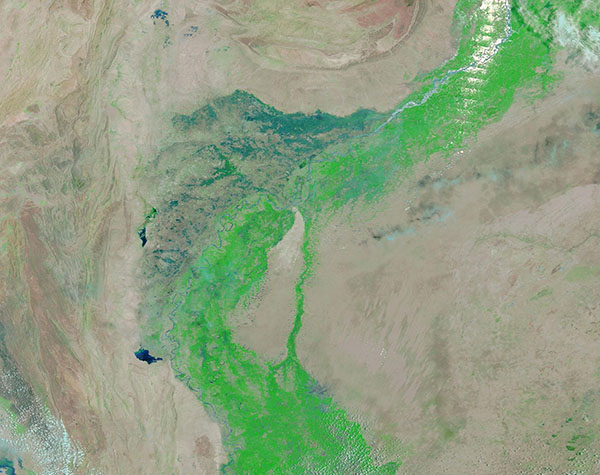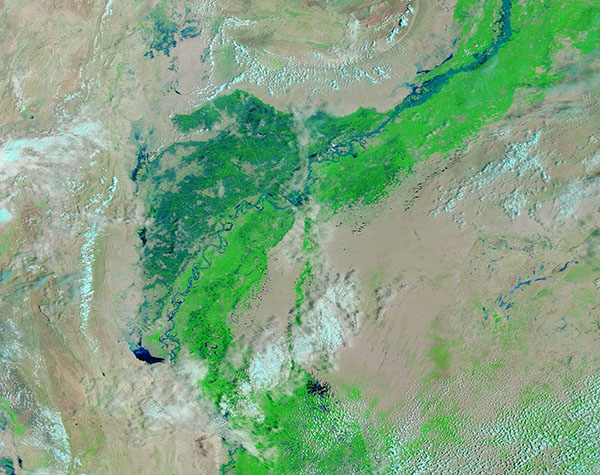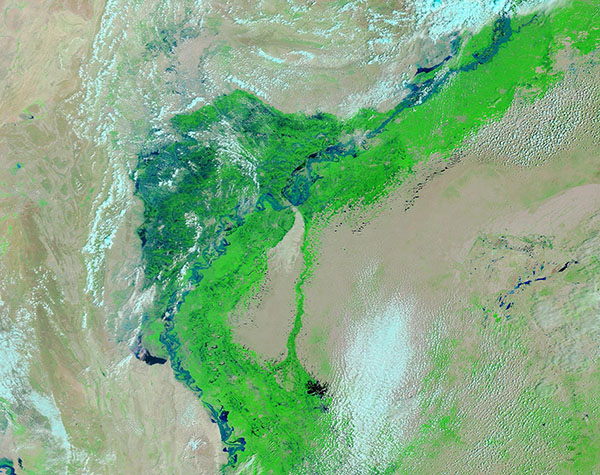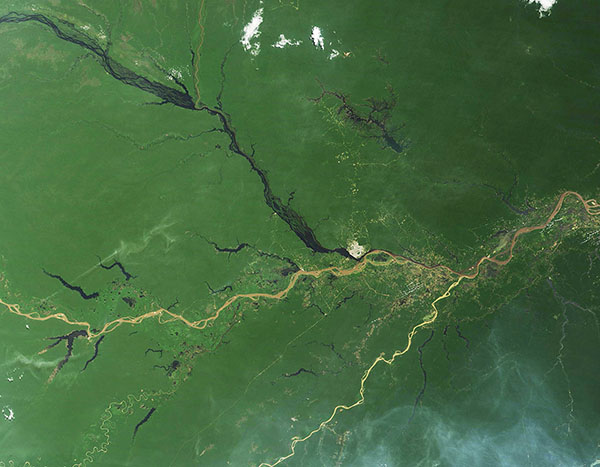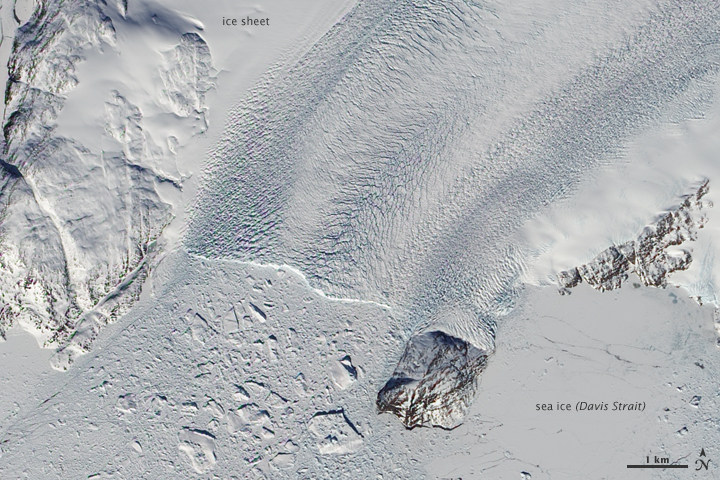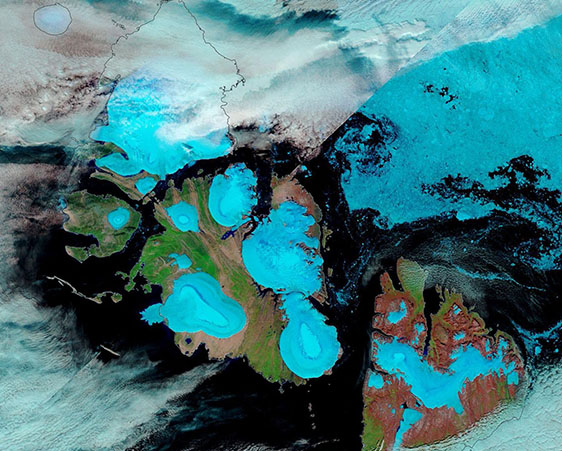Weather history miscellany
Re: Weather history miscellany
https://www.weatherforyou.com/weather_history/8-18
1988 - Twenty-two cities, from the Carolinas to the Upper Ohio Valley, reported record high temperatures for the date, pushing the total number of daily record highs since the first of June above the 1100 mark. Afternoon highs of 102 degrees at Greensboro NC and 105 degrees at Raleigh NC equalled all-time records. Evening thunderstorms in Montana produced wind gusts to 75 mph at Scobey. (The National Weather Summary) (Storm Data)
1988 - Twenty-two cities, from the Carolinas to the Upper Ohio Valley, reported record high temperatures for the date, pushing the total number of daily record highs since the first of June above the 1100 mark. Afternoon highs of 102 degrees at Greensboro NC and 105 degrees at Raleigh NC equalled all-time records. Evening thunderstorms in Montana produced wind gusts to 75 mph at Scobey. (The National Weather Summary) (Storm Data)
Re: Weather history miscellany
https://www.weather.gov/abr/This_Day_in ... ory_Aug_19
1890: An estimated F3 tornado hit South Wilkes-Barre, Pennsylvania. About 400 buildings were destroyed in the industrial and more impoverished residential section of town. The death toll was 16 and damage was estimated at $400,000. Click HERE for more information from the NWS office in Binghamton, New York.
1896: The famous Cottage City (Oak Bluffs) waterspout occurred off Martha's Vineyard, Massachusetts. The vortex was 3,600 feet high, formed three times, and was well photographed. Click HERE for more information from the Boston Globe.
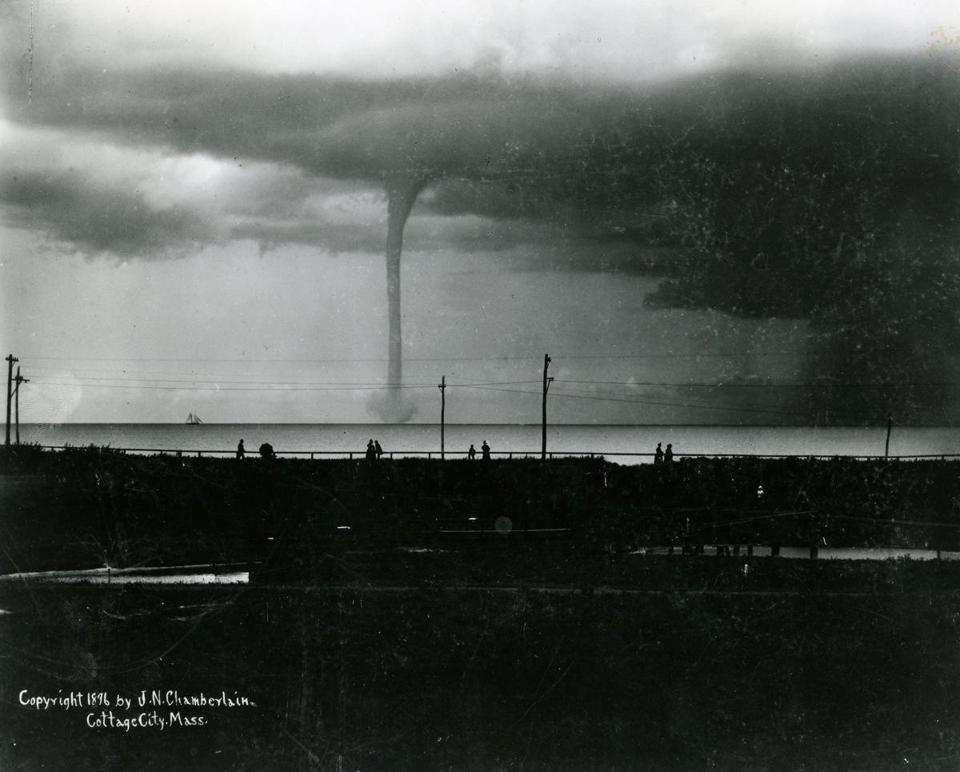
The image is courtesy of the Library of Congress Prints and Photographs Division.
Southern Ontario tornado outbreak of 2005
1890: An estimated F3 tornado hit South Wilkes-Barre, Pennsylvania. About 400 buildings were destroyed in the industrial and more impoverished residential section of town. The death toll was 16 and damage was estimated at $400,000. Click HERE for more information from the NWS office in Binghamton, New York.
1896: The famous Cottage City (Oak Bluffs) waterspout occurred off Martha's Vineyard, Massachusetts. The vortex was 3,600 feet high, formed three times, and was well photographed. Click HERE for more information from the Boston Globe.

The image is courtesy of the Library of Congress Prints and Photographs Division.
Southern Ontario tornado outbreak of 2005
Re: Weather history miscellany
https://www.weather.gov/abr/This_Day_in ... ory_Aug_20
1886: The 1886 Indianola Hurricane destroyed the town of Indianola, Texas and as such had a significant impact on the history and economic development of Texas. The storm ended the rivalry between Galveston and Indianola as the chief port of Texas. With the abandonment of Indianola and the unwillingness of the former residents to rebuild close to shore, Galveston became the essential Texan port until the 1900 Galveston Hurricane led to the rise of Houston as a major port. It was the fifth hurricane of the 1886 Atlantic hurricane season and one of the most intense hurricanes ever to hit the United States.
1910: The Great Fire of 1910 finally came to an end in Idaho. A record dry August fueled 1736 fires that burned three million acres destroying six billion board feet of timber. The fires claimed the lives of 85 persons, 78 of which were firefighters, and consumed the entire town of Wallace. The smoke spread a third of the way around the world producing some dark days in the U.S. and Canada. The forest fires prompted federal fire protection laws.
1928: A tornado estimated at F4 intensity initially touched down in Winnebago County, Iowa, moved to Freeborn County, Minnesota, and hit the south side of Austin, MN. Five of the six deaths were in Austin with 60 injuries.
1886: The 1886 Indianola Hurricane destroyed the town of Indianola, Texas and as such had a significant impact on the history and economic development of Texas. The storm ended the rivalry between Galveston and Indianola as the chief port of Texas. With the abandonment of Indianola and the unwillingness of the former residents to rebuild close to shore, Galveston became the essential Texan port until the 1900 Galveston Hurricane led to the rise of Houston as a major port. It was the fifth hurricane of the 1886 Atlantic hurricane season and one of the most intense hurricanes ever to hit the United States.
1910: The Great Fire of 1910 finally came to an end in Idaho. A record dry August fueled 1736 fires that burned three million acres destroying six billion board feet of timber. The fires claimed the lives of 85 persons, 78 of which were firefighters, and consumed the entire town of Wallace. The smoke spread a third of the way around the world producing some dark days in the U.S. and Canada. The forest fires prompted federal fire protection laws.
1928: A tornado estimated at F4 intensity initially touched down in Winnebago County, Iowa, moved to Freeborn County, Minnesota, and hit the south side of Austin, MN. Five of the six deaths were in Austin with 60 injuries.
Re: Weather history miscellany
https://www.weather.gov/abr/This_Day_in ... ory_Aug_21
1856: The Charter Oak was an unusually large white oak tree growing from around the 12th or 13th century until it fell during a windstorm on this day in 1856. According to tradition, Connecticut's Royal Charter of 1662 was hidden within the hollow of the tree to thwart its confiscation by the English governor-general. The oak became a symbol of American independence and is commemorated on the Connecticut State Quarter. Click HERE for pictures of the tree from the Connecticut Historical Society.
1856: The Charter Oak was an unusually large white oak tree growing from around the 12th or 13th century until it fell during a windstorm on this day in 1856. According to tradition, Connecticut's Royal Charter of 1662 was hidden within the hollow of the tree to thwart its confiscation by the English governor-general. The oak became a symbol of American independence and is commemorated on the Connecticut State Quarter. Click HERE for pictures of the tree from the Connecticut Historical Society.
Re: Weather history miscellany
https://www.weather.gov/abr/This_Day_in ... ory_Aug_22
1994: Hurricane John, about 345 miles south of Hilo, Hawaii had winds of 175 mph and pressure at 920 millibars or 27.17 inches of mercury, making it one of the strongest hurricanes ever in the Central Pacific. The 31-day existence made John the longest-lasting tropical cyclone recorded in both the Pacific Ocean and worldwide, surpassing both Hurricane Tina's previous record in the Pacific of 24 days in the 1992 season and the 1899 San Ciriaco hurricane's previous world record of 28 days in the 1899 Atlantic season. John was also the farthest-traveling tropical cyclone in both Pacific Ocean and worldwide, with distance traveled of 7,165 miles, out-distancing previous record holders Hurricane Fico in the Pacific of 4,700 miles in the 1978 season and Hurricane Faith worldwide of 6,850 miles in the 1966 Atlantic season.
1994: Hurricane John, about 345 miles south of Hilo, Hawaii had winds of 175 mph and pressure at 920 millibars or 27.17 inches of mercury, making it one of the strongest hurricanes ever in the Central Pacific. The 31-day existence made John the longest-lasting tropical cyclone recorded in both the Pacific Ocean and worldwide, surpassing both Hurricane Tina's previous record in the Pacific of 24 days in the 1992 season and the 1899 San Ciriaco hurricane's previous world record of 28 days in the 1899 Atlantic season. John was also the farthest-traveling tropical cyclone in both Pacific Ocean and worldwide, with distance traveled of 7,165 miles, out-distancing previous record holders Hurricane Fico in the Pacific of 4,700 miles in the 1978 season and Hurricane Faith worldwide of 6,850 miles in the 1966 Atlantic season.
Re: Weather history miscellany
NASA Earth Observatory - 2017

(July 1 - 31, 2017)
Another Hot July
Note: The colors do not represent absolute temperatures; instead they show how much
warmer or cooler an area was compared to the baseline average from 1951 to 1980.

(July 1 - 31, 2017)
Another Hot July
Note: The colors do not represent absolute temperatures; instead they show how much
warmer or cooler an area was compared to the baseline average from 1951 to 1980.
Re: Weather history miscellany
https://www.weather.gov/abr/This_Day_in ... ory_Aug_23
1724: An event is known as the "Great Gust of 1724" occurred on this day. Almost all tobacco and much of the corn crops were destroyed by this violent tropical storm, which struck the Chesapeake Bay. Intense floods of rain and a huge gust of wind were seen on the James River. Some homes were wrecked, and several vessels were driven ashore. The storm was likely followed by a second hurricane just five days later causing rain for many straight days that caused the Virginia floods of 1724.
1992: While South Florida residents were preparing for Hurricane Andrew, folks in western Montana were dealing with early season snowfall. Some snowfall amounts include 8.3” in Great Falls, 6.2” in Helena, and 5.1” in Cut Bank. This snowfall is the first significant snowfall on record in western Montana in August.
1724: An event is known as the "Great Gust of 1724" occurred on this day. Almost all tobacco and much of the corn crops were destroyed by this violent tropical storm, which struck the Chesapeake Bay. Intense floods of rain and a huge gust of wind were seen on the James River. Some homes were wrecked, and several vessels were driven ashore. The storm was likely followed by a second hurricane just five days later causing rain for many straight days that caused the Virginia floods of 1724.
1992: While South Florida residents were preparing for Hurricane Andrew, folks in western Montana were dealing with early season snowfall. Some snowfall amounts include 8.3” in Great Falls, 6.2” in Helena, and 5.1” in Cut Bank. This snowfall is the first significant snowfall on record in western Montana in August.
Re: Weather history miscellany
https://www.weather.gov/abr/This_Day_in ... ory_Aug_24
1456: Machiavelli wrote, "On the 24th of August, about an hour before day-break there arose from the Adriatic near Ancona, a whirlwind, which crossing Italy from east to west, again reached the sea near Pisa, accompanied by thick clouds, and the most intense and impenetrable darkness.” Click HERE to read this book.
1456: Machiavelli wrote, "On the 24th of August, about an hour before day-break there arose from the Adriatic near Ancona, a whirlwind, which crossing Italy from east to west, again reached the sea near Pisa, accompanied by thick clouds, and the most intense and impenetrable darkness.” Click HERE to read this book.
Re: Weather history miscellany
https://www.weather.gov/abr/This_Day_in ... ory_Aug_25
1814: In the early afternoon, a strong tornado struck northwest Washington D.C. and downtown. The severe tornadic storm arrived the day after the British Troops had set fire to the Capitol, the White House, and other public buildings. The storm's rains would douse those flames. The tornado did major structural damage to the residential section of the city. The tornado's flying debris killed more British soldiers than the guns of the American resistance. The storm blew off roofs and carried them high up into the air, knocked down chimneys and fences and damaged numerous homes. Some homes were destroyed. It lifted two pieces of cannon and deposited them several yards away. At least 30 Americans were killed or injured in the heavily damaged buildings, and an unknown number of British killed and wounded.
1948: One of the worst tornadoes to strike New Zealand occurred at Hamilton on this day. This estimated F2 tornado killed three people, injuring dozens, and destroying or severely damaging almost 150 houses and 50 business premises in Hamilton and Franklin.
More at: On 25 August 1948, NZ's deadliest recorded tornado ripped through Hamilton's Frankton suburb.
1814: In the early afternoon, a strong tornado struck northwest Washington D.C. and downtown. The severe tornadic storm arrived the day after the British Troops had set fire to the Capitol, the White House, and other public buildings. The storm's rains would douse those flames. The tornado did major structural damage to the residential section of the city. The tornado's flying debris killed more British soldiers than the guns of the American resistance. The storm blew off roofs and carried them high up into the air, knocked down chimneys and fences and damaged numerous homes. Some homes were destroyed. It lifted two pieces of cannon and deposited them several yards away. At least 30 Americans were killed or injured in the heavily damaged buildings, and an unknown number of British killed and wounded.
1948: One of the worst tornadoes to strike New Zealand occurred at Hamilton on this day. This estimated F2 tornado killed three people, injuring dozens, and destroying or severely damaging almost 150 houses and 50 business premises in Hamilton and Franklin.
More at: On 25 August 1948, NZ's deadliest recorded tornado ripped through Hamilton's Frankton suburb.
Re: Weather history miscellany
https://www.weather.gov/abr/This_Day_in ... ory_Aug_26
1864: A train running from Cincinnati to Chicago was derailed by a tornado in Dearborn County, Indiana, or 75 miles southeast of Indianapolis. Two passenger cars were lifted from the tracks and dropped in a ravine which injured 30 people.
1976: A weak tornado touched down briefly in the Hockley Hills near Kiana, AK, about 29 miles north of the Arctic Circle. This tornado is the most northerly report of a tornado on record. Kiana is 545 miles northwest of Anchorage, Alaska.
https://www.geonames.org/5864061/hockley-hills.html
1992: Hurricane Andrew made a second landfall near Burns Point, LA as a Category 3 hurricane. Morgan City, LA recorded sustained winds of 92 mph with a peak gust of 108 mph. Hammond, LA was deluged with 11.92 inches of rain. As Andrew moved inland and weakened, it spawned 47 tornadoes from this date through the 28th from the South to the Mid-Atlantic States.
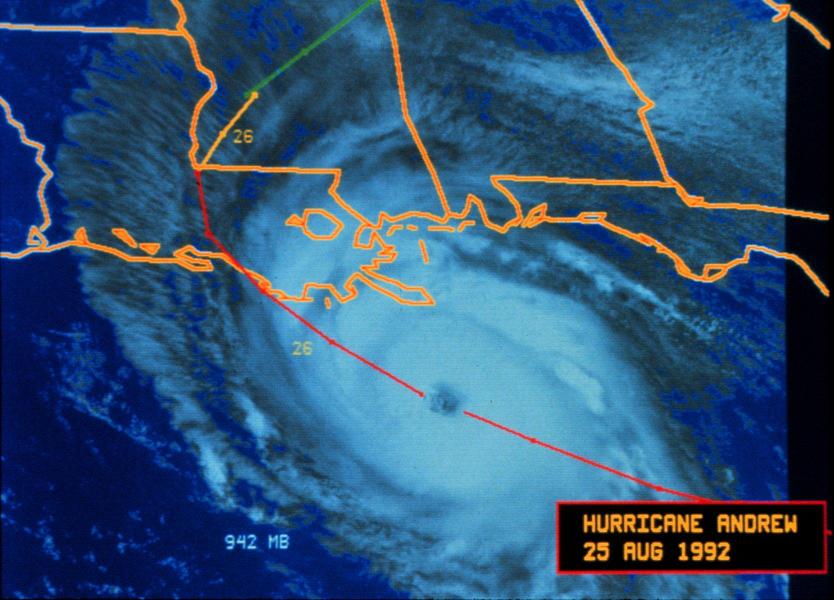
Hurricane Andrew was approaching the coast of Louisiana on August 25th, 1992.
1864: A train running from Cincinnati to Chicago was derailed by a tornado in Dearborn County, Indiana, or 75 miles southeast of Indianapolis. Two passenger cars were lifted from the tracks and dropped in a ravine which injured 30 people.
1976: A weak tornado touched down briefly in the Hockley Hills near Kiana, AK, about 29 miles north of the Arctic Circle. This tornado is the most northerly report of a tornado on record. Kiana is 545 miles northwest of Anchorage, Alaska.
https://www.geonames.org/5864061/hockley-hills.html
1992: Hurricane Andrew made a second landfall near Burns Point, LA as a Category 3 hurricane. Morgan City, LA recorded sustained winds of 92 mph with a peak gust of 108 mph. Hammond, LA was deluged with 11.92 inches of rain. As Andrew moved inland and weakened, it spawned 47 tornadoes from this date through the 28th from the South to the Mid-Atlantic States.

Hurricane Andrew was approaching the coast of Louisiana on August 25th, 1992.
Re: Weather history miscellany
https://www.weather.gov/abr/This_Day_in ... ory_Aug_27
1854: A tornado struck downtown Louisville, Kentucky around noon on Sunday, August 27th, 1854. It first touched down near 25th Street, southwest of downtown and lifted at the intersection of 5th and Main Streets. Although the tornado was only on the ground for a little over two miles, the twister claimed at least 25 lives. Many of those who perished were killed in the Third Presbyterian Church, where 55 people were gathered for Sunday church services. Straight-line winds that accompanied the tornado did significant damage to the Ohio River, where at least one boat sunk. Click HERE for more information from the NWS Office in Louisville, Kentucky.
1854: A tornado struck downtown Louisville, Kentucky around noon on Sunday, August 27th, 1854. It first touched down near 25th Street, southwest of downtown and lifted at the intersection of 5th and Main Streets. Although the tornado was only on the ground for a little over two miles, the twister claimed at least 25 lives. Many of those who perished were killed in the Third Presbyterian Church, where 55 people were gathered for Sunday church services. Straight-line winds that accompanied the tornado did significant damage to the Ohio River, where at least one boat sunk. Click HERE for more information from the NWS Office in Louisville, Kentucky.


